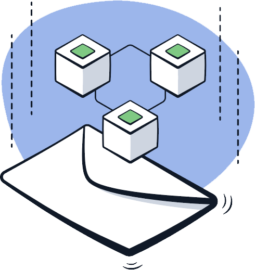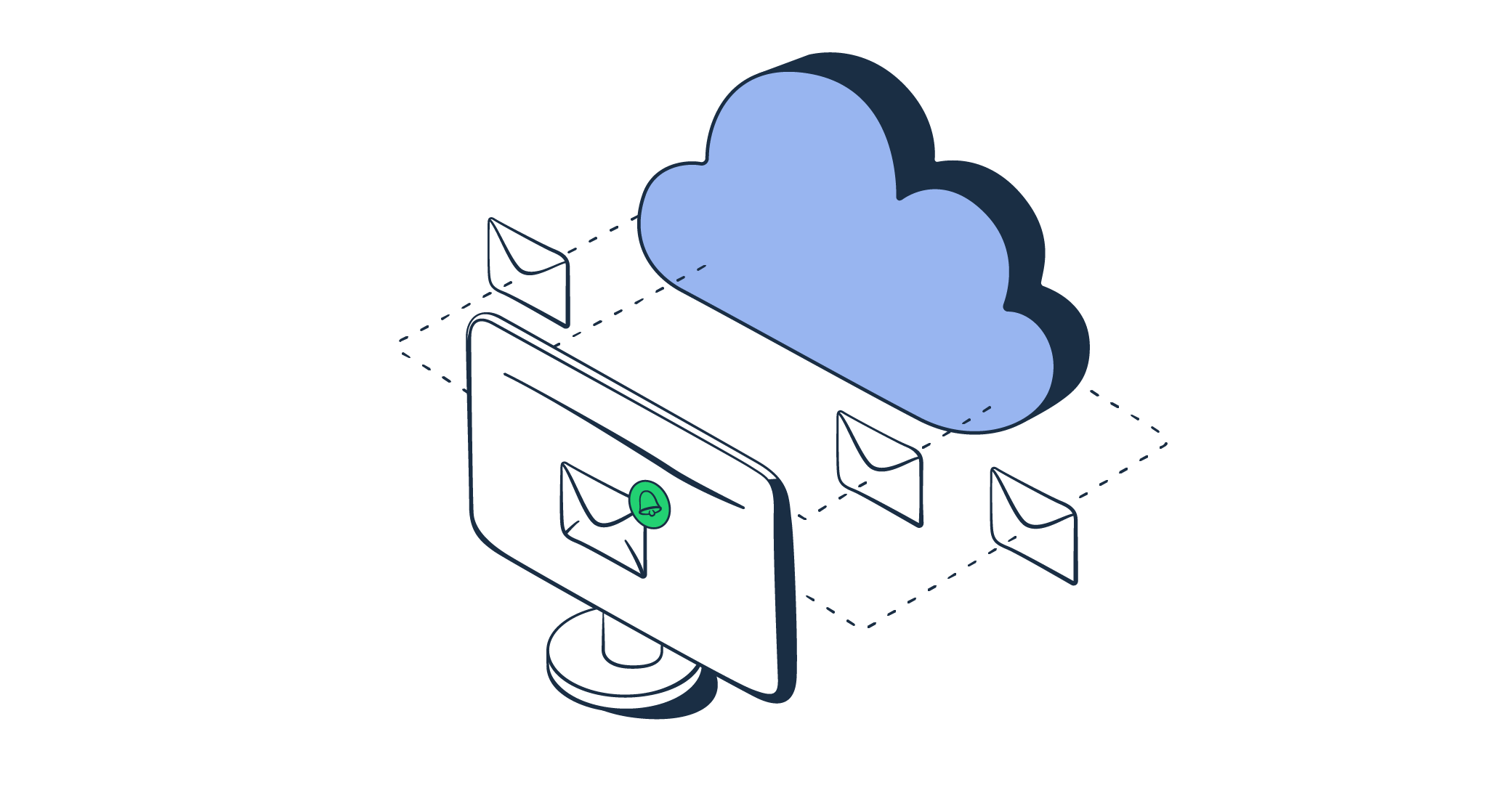Cryptocurrencies may be the most famous example of blockchain but they are definitely not the only one. Year by year, innovative blockchain-based solutions attempt to disrupt payments, banking, healthcare, insurance, and many many other industries. Among all of them, blockchain and email may not seem like the most obvious connection but it’s apparently a thing.
A number of products connecting both technologies have already emerged, and a few others are well underway. Will they succeed? What is blockchain email in the first place? Does it bring something to the table that the existing tech cannot? Let’s see.
The promise of blockchain in email
Traditional email technology has a number of flows, most concerning privacy and security. They’re addressed in various ways by implementing new authentication methods, upgrading connections, popularizing security, and encryption standards.
The improvements bring benefits such as limiting spam, phishing, or data theft – but definitely do not eradicate them. As a result, some started viewing blockchain as the technology capable of turning things around. It brings along several significant advantages.
Email authentication
Blockchain is a decentralized ledger, storing information about each transaction that has taken place in the network. Each piece of data is authenticated by multiple computers present in the network, making it virtually impossible to impersonate any party involved.
The ability to authenticate with such a reliable mechanism would remove a lot of hurdles present in the current approaches. Although the adoption of email authentication methods such as SPF, DKIM, and DMARC keeps growing, they’re not bulletproof.
Misconfigurations are still common and can undermine their effectiveness, so it’s worth verifying your setup using tools like our free SPF, DKIM and DMARC record checkers. So phishing attacks can and still happen even on authenticated domains. Mistakes by domain owners may cause perfectly good emails to be discarded, and the constant optimization burns the resources desperately needed elsewhere.
What’s more, the adoption of DMARC, the most sophisticated method available, is still ages away from the desired levels. For example in 2021, for the banking sector, arguably one of the most vulnerable for any sort of abuse, it is still relatively low.
Email based on blockchain would allow for easy verification of each email sender, leaving no room for scammers of any sort to alter the authentication results. It would give the recipient confidence that the sender is indeed who they say they are.
Security
SMTP standard doesn’t guarantee encryption of a message across its entire journey, from one inbox to another.
Modern email providers, including Gmail or Hotmail, incorporate encryption techniques such as TLS or SSL by default. Most often, they’re only applied when an email is dispatched and later retrieved on the recipient’s end. As a message wanders between email servers, it’s not encrypted, and as such, susceptible to interception.
This issue is already addressed by end-to-end encryption services, such as Proton Mail. An email is encrypted with an individual private key and can only be decrypted with a corresponding public key, virtually impossible to obtain without the sender’s approval.
With Blockchain, emails probably wouldn’t move between email servers. They probably wouldn’t even be sent in a typical understanding of it. Instead, they would be fetched from someplace in the blockchain and rendered to the recipient upon request.
Privacy
A big reason why people flock to alternative email solutions is privacy. The biggest email services are free but the payment happens with our personal data.
Large corporations such as Google scan through the content of our emails, gauging our interests. Then, they monetize the data obtained this way with targeted advertising, or by feeding other functionalities. Some could go as far as selling this data to third parties, with or without users’ consent.
Sending sensitive data over SMTP servers is also a big no-go for political dissidents, whistle-browsers, and virtually anyone in notable public positions. There are just too many risks involved.
With email on a blockchain, the contents of each message would be stored on a decentralized ledger, far from the inquisitive eyes of email providers. No one but the sender and recipient could access it, leaving no space for data breaches and not-so-innocuous advertisers. This focus on security is attracting a lot of interest from security professionals, with some even considering pursuing blockchain technology certifications to better understand and implement these solutions or reviewing web3 jobs to hire dedicated developers.
Top blockchain email providers
Blockchain email is still in its infancy, for that reason the number of ready-to-use options is still quite limited. The others are still in beta, accepting limited numbers of new users and prepping up for the big launch. Here are some of the existing options:
CryptaMail
CryptaMail is a decentralized email service that doesn’t rely on physical servers – instead, it stores all messages on a blockchain. The cloud-based inbox is accessible with a password.
CryptaMail is built on top of the NxtCoin 2.0 protocol, guaranteeing a secure transmission. Each message is automatically encrypted when dispatched and will only be decrypted upon its arrival to the recipient’s inbox.
CryptaMail is currently in beta.
Mailchain
Mailchain allows for exchanging email-like messages between Blockchain users. The messages can contain HTML, attachments, and other elements of typical emails.
The messages are not stored in blockchain, though – instead, they opted to store it off-chain (outside of Blockchain) to limit the amount of data on a blockchain. You can access Mailchain via Mac, Linux, and Windows clients.
LedgerMail
LedgerMail provides end-to-end encryption for all emails. It replaces the typical SMTP connection that empowers traditional email and adds a solid security layer. It can also be integrated with existing Outlook/Gmail accounts.
All messages are stored in a decentralized blockchain, and the LedgerMail team claims to do its part to limit energy consumption and boost the pace of transmission.
The issues with blockchain email
Email services based on blockchain are still rather scarce, and it’s uncertain if the trend will change. There are some doubts about the feasibility of the technology that each company will eventually have to overcome. These are:
Storage requirements
The most common use for blockchain is obviously cryptocurrencies, the biggest one being bitcoin. Due to the nature of blockchain, each transaction record needs to reside on every single computer in the network. The more transactions occur, the heavier blockchain becomes.
As of the beginning of 2022, Bitcoin needs roughly350 gigabytes of storage space, and this number is only set to grow. It’s worth noting that we’re talking here about hashed, plain text transactions that weigh maybe a few hundreds of bytes each.
Compare that with content-heavy emails containing images, attachments, and lots of HTML, that can easily go into several megabytes each. The sheer volume of emails sent is also huge, amounting to trillions of messages sent every day. If the entire email infrastructure was to move to the blockchain, there’s just no way this could be stored anywhere in the network.
The potential solution is to store messages off-chain, something that Mailchain, for example, does already. In that case, blockchain could be used only to authenticate senders, ideally through a trusted RPC node provider for reliable verification.
Privacy
If companies did find a way to store messages on the blockchain, it would raise more concerns. After all, each message that you’ve ever sent would be available throughout the network. You wouldn’t even be able to delete it.
Of course, each message would be encrypted but certain details (time stamps or metadata) would need to be accessible for verification purposes. Some would say that this is not precisely the idea of a 100% privacy-focused network.
Storing messages off-chain also raises concerns. After all, emails would need to be held on physical servers, just like any other existing email infrastructure. It’s not necessarily a dealbreaker but may not be what some fans of blockchain technology envisioned.
Compatibility
When an email is sent from a blockchain-based client to another user on the network, the copy of the message stays within the network. The problem appears when you wish to contact someone using the traditional email infrastructure.
In this case, a copy of each message will also be stored in their inbox, outside of the blockchain, which ruins the idea of using blockchain in the first place.
For that reason, some companies started developing isolated systems where messages can only be sent between users in a network. It’s definitely a much more secure option but is very limiting for an average user that has contacts mostly (if not only) outside of the network.
LedgerMail, for example, allows for emailing regular email recipients. Emails are delivered as usual (via SMTP) but a recipient uses the app to decrypt them. These kinds of hybrid solutions are likely to emerge as the winners if blockchain email is to succeed.
Scalability and cost
Globally, roughly 330 billion emails pass back and forth per day. To cope with this particular volume of transactions, the blockchain-based email system needs to handle extreme throughput per second which is not the case with blockchain technologies currently. LedgerMail, for example, built on top of XinFin, a proof-of-stake network, and boasting far greater throughput capacities than Etherum or Bitcoin, is still able to process only about 0.06% of global email interactions within 24 hours. And this is true only if XinFin concentrates solely on email transactions, casting aside all other blockchain-related services.
Scalability is tightly bound to another important issue: cost. Most public blockchain networks charge a transaction fee for the information or value exchange. It is a necessary prerequisite for incentivizing participation and ensuring maximum levels of security. The sums for transaction fees correlate directly with the amount of traffic on the blockchain network. Thus, the more popular blockchain email becomes, the more expensive email exchange gets.
Alternatives to blockchain-based email
There’s certainly potential in email solutions built on top of a blockchain.
Email security will be a focus for many years to come. It will certainly be a priority for enterprises, particularly vulnerable to all sorts of misconduct. The unique offering of a decentralized, ultra-secure (in theory) blockchain will seem like a perfect fit for many different use cases.
As you could read above, there’s also a lot of obstacles ahead for blockchain-based email. Because of this, we’re unlikely to see purely blockchain-based solutions gaining massive popularity. We’re more likely looking at sort of hybrid solutions that use blockchain to add an extra layer of security but work with an old-fashioned SMTP structure under the hood.
Things could change, of course. But if security is your top concern, it’s probably worth also looking at alternative solutions that have gained a lot more traction and are at a far more mature level already than blockchain-based services.
Here are some of the most popular alternatives:
ProtonMail
ProtonMail is a Swiss-based project that provides end-to-end encryption for all emails. It’s open-sourced, allowing you to access the entire source code, including the encryption libraries used in the product.
Each email can be set to auto-destruct at a specified time. You can email both ProtonMail users as well as any other email address. For internal conversions, emails will be automatically encrypted and decrypted upon arrival.
When sending emails outside of Proton, the recipient will only be able to decrypt them after typing in a password. By default, they’ll also self-destruct after 28 days.
ProtonMail is free with up to 500MB of storage. More capacity, as well as features, are available with premium plans.
Tutanota
Tutanota is a similar service to ProtonMail, though not as popular. It’s also open-source and provides end-to-end encryption. It allows messaging both internal and external recipients and provides a number of handy features, such as 2FA, white labels, encrypted calendars, and others.
The service is free with up to 1GB of storage. If you require more, premium plans are also available with additional features.
Mailfence
Mailfence is another privacy-focused email service, proudly displaying on their website the quote: “privacy is a right, not a feature”.
It offers the standard end-to-end encryption, 2FA, 500MB of storage, and more. It also works with its own digital signatures, giving the recipients the confidence that emails were indeed sent by you. Along with the service comes an encrypted calendar, storage spaces, and contacts.
Anxious for more? We’ve covered the topic in-depth in our article on email encryption software.
Final words
Blockchain email is certainly an interesting topic. However, at this point it’s hard to say if it can become the future of email. Compared to the more popular decentralized services, such as ProtonMail, it doesn’t actually offer much of an upside in its current shape.
It may evolve, though. It may overcome the main obstacles ahead of the technology, and even turn them into advantages. Only time will tell if blockchain email can become an industry standard or if it will remain just the small niche that it is today.




